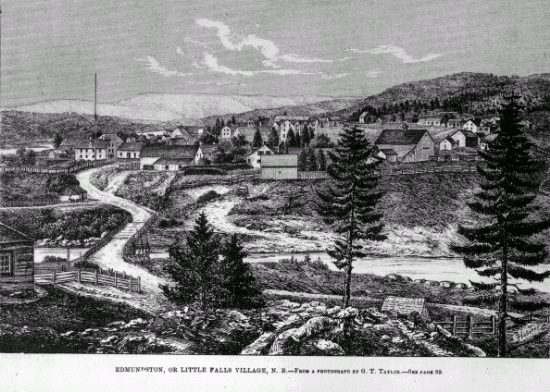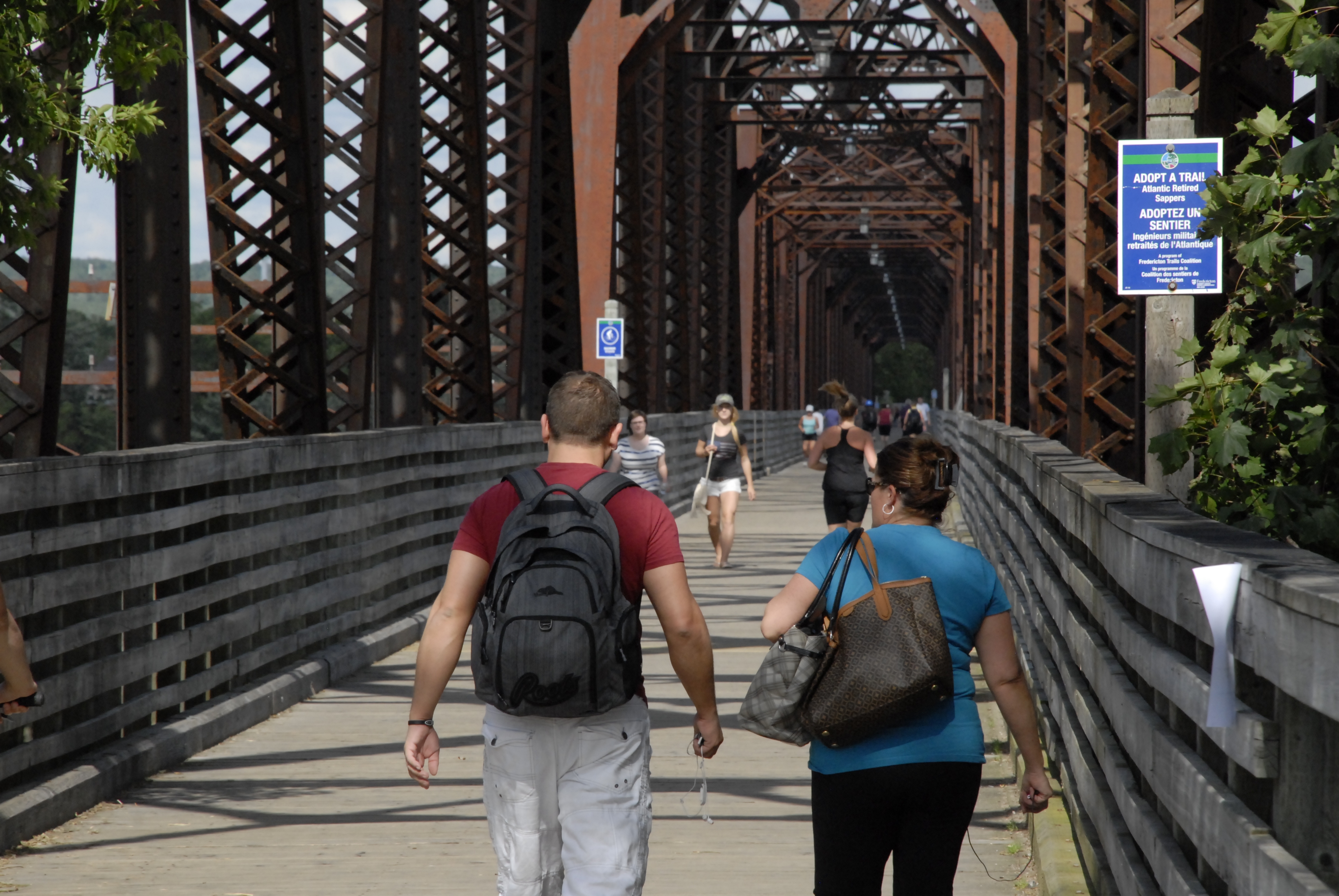|
Madawaska River (Saint John River Tributary)
The Madawaska River flows from Lake Témiscouata in Quebec, through Degelis, Quebec, to join the Saint John River at Edmundston, New Brunswick. The course of the Madawaska River is accessible in Quebec by route 185 and New Brunswick by Highway 2, which run along the river side South West. Toponymy Various theories exist over the etymology of the word Madawaska. One is that the river's name comes from the Algonquian word "Madoueskak", which means "land of the porcupine". In Maliseet, the word "Matawaskiyak" translates to "at the place where water flows out over grass", there is also speculation that it refers to the 'meeting of two rivers where there is grass'. The Madawaska river is a large drainage basin for Lake Temiscouata and other waterways from the north. Before the city of Edmundston changed the natural course of the river, the spring freshet would cause several branches of the river to flood the land resulting in various waterfalls. The river formed part of the Tém ... [...More Info...] [...Related Items...] OR: [Wikipedia] [Google] [Baidu] |
Commission De Toponymie Du Québec
The Commission de toponymie du Québec (English: ''Toponymy Commission of Québec'') is the Government of Québec's public body responsible for cataloging, preserving, making official and publicize Québec's place names and their origins according to the province's toponymy rules. It also provides recommendations to the government with regard to toponymic changes. Its mandate covers the namings of: * natural geographical features (lakes, rivers, mountains, etc.) * constructed features (dams, embankments, bridges, etc.) * administrative units (wildlife sanctuaries, administrative regions, parks, etc.) * inhabited areas (villages, towns, Indian reserves, etc.) * roadways (streets, roads, boulevards, etc.) A child agency of the Office québécois de la langue française, it was created in 1977 through jurisdiction defined in the Charter of the French Language to replace the Commission of Geography, created in 1912. See also * Toponymy * Toponym'elles * Office québécois de la lang ... [...More Info...] [...Related Items...] OR: [Wikipedia] [Google] [Baidu] |
Canadian National Railway
The Canadian National Railway Company (french: Compagnie des chemins de fer nationaux du Canada) is a Canadian Class I freight railway headquartered in Montreal, Quebec, which serves Canada and the Midwestern and Southern United States. CN is Canada's largest railway, in terms of both revenue and the physical size of its rail network, spanning Canada from the Atlantic coast in Nova Scotia to the Pacific coast in British Columbia across approximately of track. In the late 20th century, CN gained extensive capacity in the United States by taking over such railroads as the Illinois Central. CN is a public company with 22,600 employees, and it has a market cap of approximately CA$90 billion. CN was government-owned, having been a Canadian Crown corporation from its founding in 1919 until being privatized in 1995. , Bill Gates is the largest single shareholder of CN stock, owning a 14.2% interest through Cascade Investment and his own Bill and Melinda Gates Foundation. Fr ... [...More Info...] [...Related Items...] OR: [Wikipedia] [Google] [Baidu] |
Cabano, Quebec
Cabano is a former city in Témiscouata Regional County Municipality within the Bas-Saint-Laurent region of Quebec, Canada. It is situated on Lake Témiscouata on Autoroute 85. On May 5, 2010 it merged with Notre-Dame-du-Lac to form the new city of Témiscouata-sur-le-Lac. History At first, Cabano was called ''Poste du Lac'' or ''Fort Ingall''. It became Saint-Mathias-de-Cabano in 1907, then the municipal village of Cabano in 1923, and finally, the city of Cabano in 1962. On May 9, 1950, a major fire destroyed 125 houses in the city. TFI International, Canada's largest trucking company, was founded in Cabano. Notable people * Paul Triquet - Recipient of the Victoria Cross for actions in Italy during the Second World War * Ingrid St-Pierre Ingrid St-Pierre (born in 1985) is a French Canadian singer-songwriter from Quebec. Biography Ingrid St-Pierre was born and raised in Cabano, a town within the Bas-Saint-Laurent region of Quebec, Canada. Her father is a businessman whil ... [...More Info...] [...Related Items...] OR: [Wikipedia] [Google] [Baidu] |
Edmundston, New Brunswick
Edmundston is a city in Madawaska County, New Brunswick, Canada. On 1 January 2023, Edmundston will expanded, annexing the village of Rivière-Verte and parts of the local service districts of the parish of Saint-Jacques and the parish of Saint-Joseph. History During the early colonial period, the area was a camping and meeting place of the Maliseet (Wolastoqiyik) Nation during seasonal migrations. From the mid to late eighteenth century, one of the largest Maliseet villages had been established at Madawaska and had become a refuge site for other Wabanaki peoples. The Maliseet village was originally located near the falls at the confluence of the Madawaska and Saint John Rivers. Currently, the City of Edmundston surrounds a federal Indian Reserve (St. Basile 10/Madawaska Maliseet First Nation). Originally named ''Petit-Sault'' (Little Falls) in reference to the waterfalls located where the Madawaska River merges into the Saint John River, the settlement was renamed ''Edmun ... [...More Info...] [...Related Items...] OR: [Wikipedia] [Google] [Baidu] |
Rail Trail
A rail trail is a shared-use path on railway right of way. Rail trails are typically constructed after a railway has been abandoned and the track has been removed, but may also share the right of way with active railways, light rail, or streetcars (rails with trails), or with disused track. As shared-use paths, rail trails are primarily for non-motorized traffic including pedestrians, bicycles, horseback riders, skaters, and cross-country skiers, although snowmobiles and ATVs may be allowed. The characteristics of abandoned railways—gentle grades, well-engineered rights of way and structures (bridges and tunnels), and passage through historical areas—lend themselves to rail trails and account for their popularity. Many rail trails are long-distance trails, while some shorter rail trails are known as greenways or linear parks. Rail trails around the world Americas Bermuda The Bermuda Railway ceased to operate as such when the only carrier to exist in Bermuda folded in 1948. ... [...More Info...] [...Related Items...] OR: [Wikipedia] [Google] [Baidu] |
Petit Témis Interprovincial Linear Park
Petite or petite may refer to: * Petit (crater), a small, bowl-shaped lunar crater on Mare Spumans * ''Petit'' (EP), a 1995 EP by Japanese singer-songwriter Ua *Petit (typography), another name for brevier-size type * Petit four *Petit Gâteau * Petit Jean State Park, Arkansas, United States * Petit juror * Petite bourgeoisie in sociology * petite mutation, a mutation in yeast oxidative phosphorylation * Petite sizes in women's clothing *Petit's triangle (inferior lumbar triangle), see Petit's hernia People *A French or Catalan surname: **Adriana Petit (born 1984), Spanish multidisciplinary artist ** Alexis Thérèse Petit (1791–1820), French physicist **Amandine Petit (born 1997), French model, beauty pageant titleholder, and Miss France 2021 **Antoine Petit (1722–1794), French physician **Antoni Martí Petit, prime minister of Andorra ** François Pourfour du Petit (1664–1741), French anatomist ** Henriette Petit (1894-1983), Chilean painter **Jean-Martin Petit (1772–1 ... [...More Info...] [...Related Items...] OR: [Wikipedia] [Google] [Baidu] |
Trans-Canada Highway
The Trans-Canada Highway ( French: ; abbreviated as the TCH or T-Can) is a transcontinental federal–provincial highway system that travels through all ten provinces of Canada, from the Pacific Ocean on the west coast to the Atlantic Ocean on the east coast. The main route spans across the country, one of the longest routes of its type in the world. The highway system is recognizable by its distinctive white-on-green maple leaf route markers, although there are small variations in the markers in some provinces. While by definition the Trans-Canada Highway is a highway ''system'' that has several parallel routes throughout most of the country, the term "Trans-Canada Highway" often refers to the main route that consists of Highway 1 (British Columbia, Alberta, Saskatchewan, and Manitoba), Highways 17 and 417 (Ontario), Autoroutes 40, 20 and 85 (Quebec), Highway 2 (New Brunswick), Highways 104 and 105 (Nova Scotia) and Highway 1 (Newfoundland). This ma ... [...More Info...] [...Related Items...] OR: [Wikipedia] [Google] [Baidu] |
Quebec Route 185
Route 185 is part of the Trans-Canada Highway. It travels from Saint-Antonin to Saint-Louis-du-Ha! Ha!, a distance of about . It connects the 2 sections of Autoroute 85 and is the former designation for all of A-85. The southern section of the highway follows the valley of the Madawaska River. At present, Route 185 is a 2-lane highway with passing lanes. Often cited as one of the most dangerous highways in Canada, it is slowly being upgraded to Autoroute standards and is eventually planned to be a 4-lane restricted-access freeway, assuming and extending the existing Autoroute 85 designation. Several sections have been completed and opened as such. Once this upgrade is completed, it will close the last gap in what would become a continuous freeway section of the Trans-Canada between Renfrew, Ontario, and Antigonish, Nova Scotia - a length of over 1,500 km (900 mi), and for an even longer interprovincial freeway route between Windsor, Ontario and Halifax, Nova Scotia - a lengt ... [...More Info...] [...Related Items...] OR: [Wikipedia] [Google] [Baidu] |




